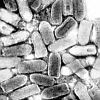
Vesicular stomatitis virus
Genus: Vesiculovirus

In animals, incubation is usually 2-9 days, and lesions develop 2-5 days after exposure. VSV infection is often subclinical or asymptomatic in humans.
VSV is present only in the Western hemisphere. It is enzootic in Southern Mexico, Central America, and some regions of South America as well as Ossabaw Island, off the coast of Georgia, United States. In the rest of the US the disease is sporadic among cattle, horses, and pigs. In temperate zones outbreaks begin in the late summer and end at the first frost. In tropical areas, appears at the end of the rainy season and disappears at the beginning of the dry season.
VSV must be introduced into a person beneath the skin and mucous membranes through wounds or other openings in the skin. Infection is often subclinical , but may also cause a flu-like syndrome and vesicular herpes-like lesions in mouth, over the lips and mucosa.
Since VSV does not cause severe disease in humans, avoiding contact with livestock suspected to be infected is sufficient for prevention. Supportive verterinary care of infected animals prevents complications and speeds recovery.
Vaccination of cattle, horses, and pigs could control VSV spread. There is a live attenuated vaccine available, but it has rarely been used.
References:
Knipe DM and Howley PM, eds. Fields Virology, Fourth Edition. Philadelphia: Lippincott Williams & Wilkins, 2001. pp. 1245-1267.